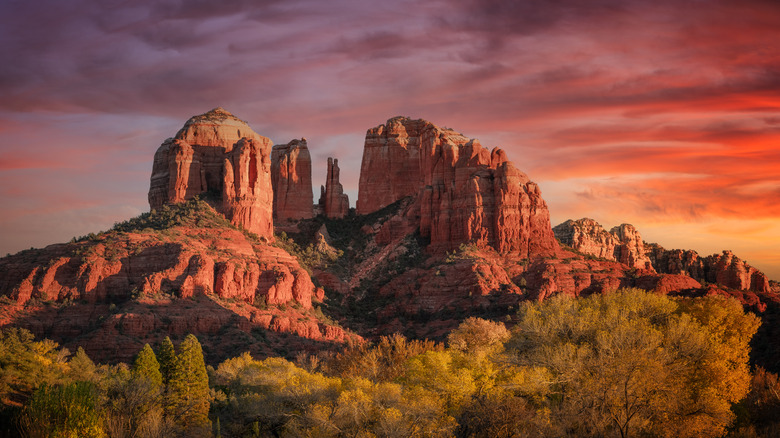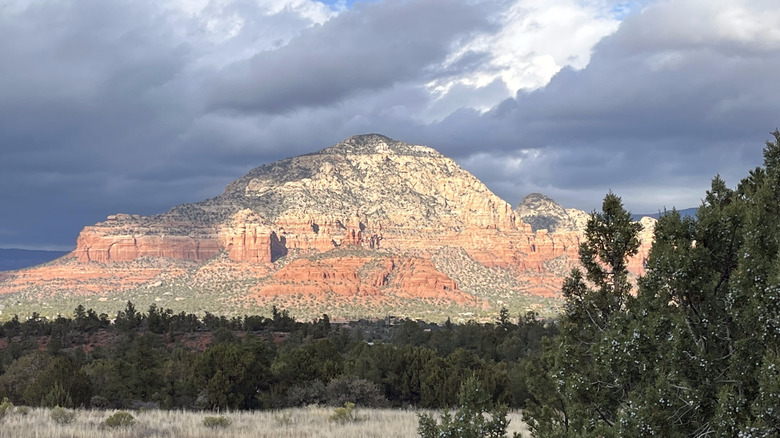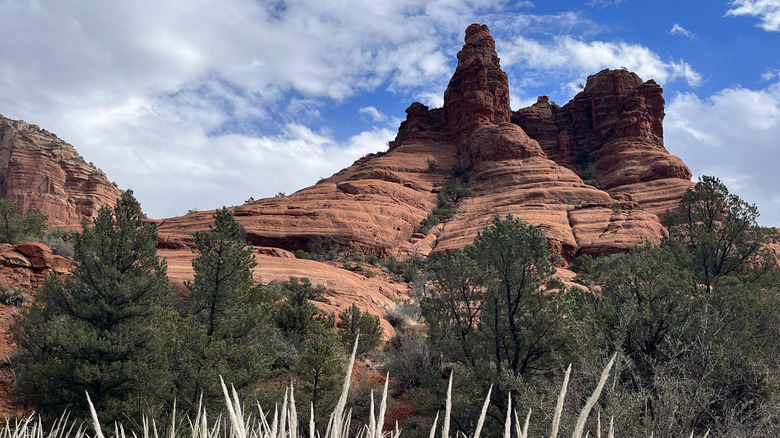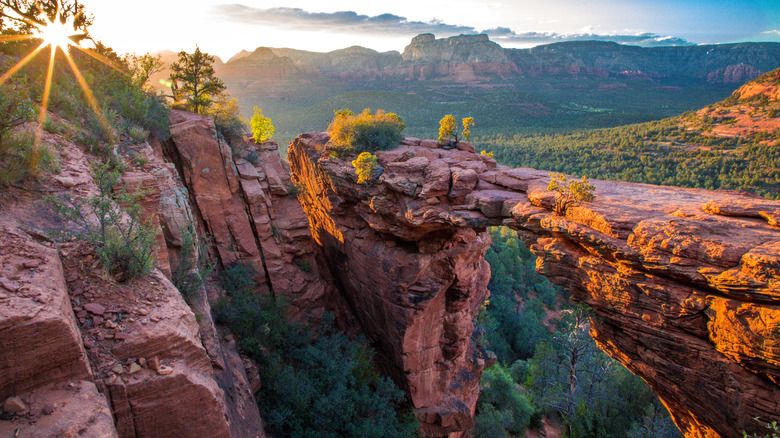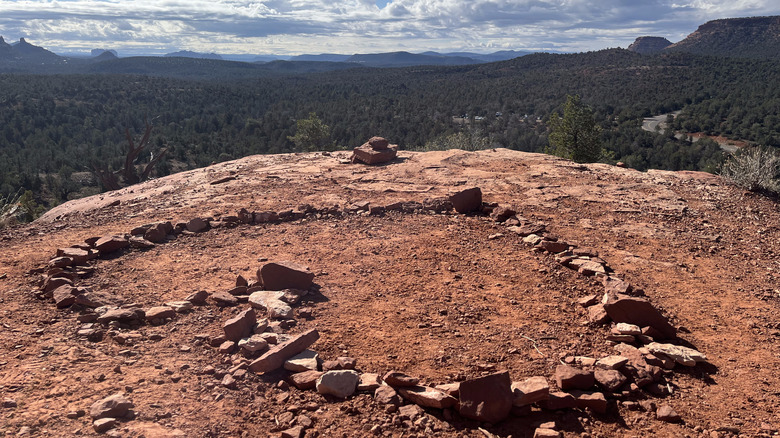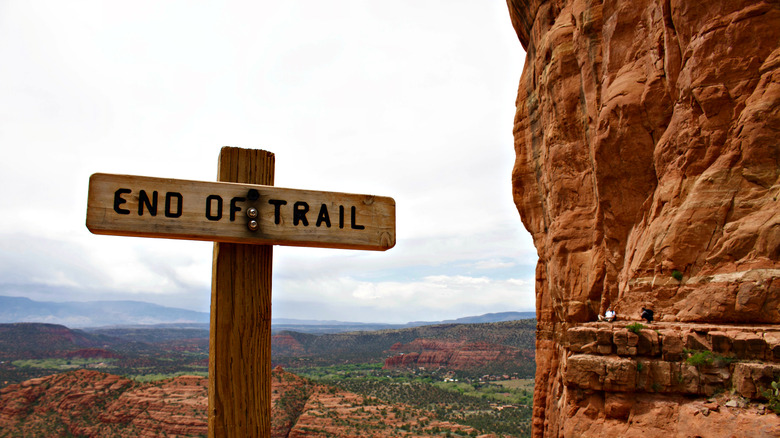Sedona, Arizona Is A Hiker's Paradise. Here's Why
Surrounded by crimson canyon walls, iconic red rock buttes, and ponderosa pine forests, Sedona is a stunning small city. While also well-known for its new-age shops, upscale spas, and vibrant art scene, Sedona is an incredibly popular hiking destination — and for good reason.
Located between Phoenix and the Grand Canyon, Sedona is flanked by the 286-acre Red Rock State Park and the Coconino National Forest, which spans more than 1.8 million acres in northern Arizona. Needless to say, the natural beauty that surrounds Sedona draws droves of nature lovers and hikers each year.
Sedona boasts a network of over 200 trails covering 400 miles, so whether you're a novice or an experienced hiker, the area offers plenty of hiking opportunities to accommodate your skill level. However, with a variety of trails offering innumerable natural highlights, as well as plenty of in-town attractions, planning your hikes wisely is essential, especially if your Sedona visit is part of a larger Grand Canyon itinerary.
Plan for parking (or lack thereof)
If you're planning a hiking trip to Sedona, you'll really need a plan (and a backup plan). Although Sedona has no shortage of trails, the city's infrastructure just hasn't kept up with the annual influx of visitors. The city of Sedona is home to around 10,000 year-round residents, but the popular destination hosts around 3 million tourists each year. However, regardless of its popularity, Sedona prioritizes protecting its natural areas, which is important. That said, the parking in and around Sedona is incredibly limited, especially near popular trailheads.
To snag a coveted parking spot near a trailhead, you'll need to arrive early. Real early. During peak season, which is typically spring, you'll need to arrive before sunrise. While perhaps initially painful, early risers are usually rewarded with fiery sunrises that paint multicolored bluffs with golden rays and squint through rock spires. It's truly amazing.
If you're just not a morning person (or you're herding a large family), Sedona does provide a free public shuttle service to a few popular trailheads. In the spring, from March to mid-April, the Sedona Shuttle runs every day. However, the shuttle only operates from Thursdays to Sundays the rest of the year.
Popular Sedona hikes for beginners
As stated, the network of trails that weave around Sedona is vast. So although trails can be categorized as easy, you can always combine trails, take detours, and climb bluffs for a more physically intense experience.
For instance, the Bell Rock Loop is a quick, relatively flat (and incredibly popular) 1.5-mile trail. However, many hikers combine this trail with the Courthouse Butte Loop, adding more distance. Most hikers also scramble up Bell Rock, one of Sedona's most iconic natural structures. Point is, while a categorically easy hike, the Bell Rock Loop is still a "choose your own adventure" experience.
Another favorite of novice hikers is the Boynton Canyon Vista Trail. Only a 1.2-mile trail (in and out), the relatively easy trail does involve climbing rock stairs to reach the vista under the Boynton Spires. However, once completing the moderately difficult climb, you're rewarded with sweeping views that include popular natural landmarks such as Deadman's Pass, Mescal Mountain, Chimney Rock, and Courthouse Butte.
Experienced hikers are often rewarded
Due to Sedona's landscape with plenty of vertical climbs, difficult hikes are typically categorized in terms of a hiker's threshold for heights, as well as the trail's length and overall trail elevation. Two of Sedona's most popular hikes are prime examples: Cathedral Rock Trail and Devil's Bridge Trail. In both instances, you could define the trails as either easy or difficult, depending on your comfort with elevation.
Cathedral Rock Trail is only 1.5 miles round-trip from its trailhead, but as one of the most popular trails in Sedona, parking is notoriously scarce. Overflow parking can be found at Yavapai Point, which will add a few miles to your overall hike. While the hike on Templeton Trail to reach Cathedral Rock Trail from Yavapai Point is relatively easy, you've then met Cathedral Rock Trail, which is more of a rock climb than a hike. However, the view from between the famed spires is remarkable.
The Devil's Bridge Trail is a little different. While parking is still an issue (similar to everywhere), it's not impossible to find a spot. Home to a natural sandstone arch (the Devil Bridge), the trail is incredibly popular. For experienced hikers, crossing the narrow bridge after a pretty steep (and typically crowded) hike is a Sedona trip highlight. But for beginner hikers, the views over steep canyon walls, along with the sheer crowd size bustling for photo opportunities, could be intimidating.
Sedona's vortexes
Sedona is certainly an epic destination for hikers, but the city is also known for its quirky, new age personality. In fact, people travel from all over the world to Sedona to experience the fabled cosmic forces purportedly emanating from the area's red rocks. When these forces begin to amass and swirl at a particular location, they create so-called vortexes.
Sedona is said to be home to several of these vortexes. Whether created by electromagnetic fields or less-understood cosmic energy, three of Sedona's famed vortexes can be found at the trails we've already discussed: the Boynton Canyon Vortex, Cathedral Rock Vortex, and Bell Rock Vortex.
While hiking, you'll see people performing yoga, chanting, or simply meditating at particular vortex locations. Many people report feeling recharged, balanced, or healed after visiting a vortex. Whether you believe this or not, many vortex locations provide outstanding views and offer a chance to find harmony immersed in your natural surroundings.
What to do after the trail ends
After a long day on the trails, you'll find plenty of ways to unwind within the city. Sedona boasts a remarkable number of upscale spas, wellness centers, and eclectic shops selling Native American, Eastern, and new-age healing products. Along with crystals, handmade jewelry, and other metaphysical products, many shops also prepare elixirs and natural juices to help trail-weary hikers recharge.
As you can probably imagine, the city's free-thinking reputation also attracts plenty of artists, making Sedona an excellent destination for perusing art galleries. If you're looking for a little food and shopping to round out your trip to Sedona, consider exploring the Tlaquepaque Arts & Shopping Village, an outdoor market featuring restaurants, breweries, craft shops, and popular art galleries. Compared to some of Sedona's bluff-climbing hikes, the cobblestone pathways that connect the quaint shops and shaded patio eateries of the Tlaquepaque Arts & Shopping Village should make for happy, less-intense trails.
